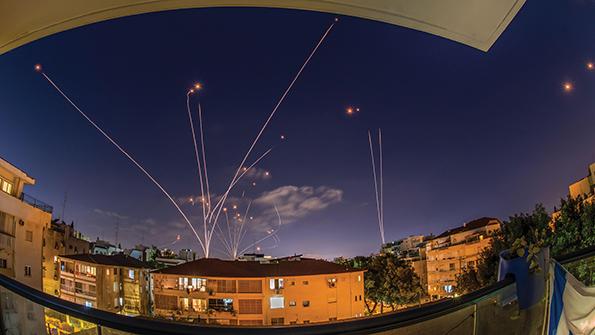This article is published in Aviation Week & Space Technology and is free to read until Aug 30, 2024. If you want to read more articles from this publication, please click the link to subscribe.

While Israel has relied on the Iron Dome system to protect its airspace, the UK Royal Air Force chief says Europe cannot afford such a system.
Europe is feeling the pressure to step up its defense against diverse air and missile threats while confronting the uncomfortable reality that doing so at scale might be unaffordable.
The European Union must bolster its defenses and consider pursuing a European Air Shield, EU President Ursula von der Leyen said on July 18, just before being confirmed for a second term. She called for a comprehensive aerial defense system “not only to protect our airspace but as a strong symbol of European unity in defense matters.”
- “We cannot protect everything all of the time,” Royal Air Force Chief says
- Defense companies are boosting capacity to make more interceptors amid strong demand
Europe was spurred into action following Russia’s 2022 full-scale invasion of Ukraine as well as Yemen-based Houthi forces’ drone and missile attacks on international shipping. In addition, the Israel Defense Forces said on July 19 that an Iranian uncrewed aircraft system fired from Yemen struck a residential building in Tel Aviv.
“We have to look again at how we fight, how we strengthen air and missile defense, look at our countermeasures, and get that right up the agenda,” Luke Pollard, the UK’s new defense minister, said on July 18 at the Global Air and Space Chiefs’ Conference in London. It was the new Labour government’s clearest commitment to air and missile defense, coming at the launch of a defense review expected to stretch into 2025.
“What we have seen in the attacks on Ukraine—not only front-line forces but critical national infrastructure and civil targets—by Russia is that air defense has a new level of importance,” Pollard said, noting that the threat is not just from sophisticated systems but swarms of inexpensive uncrewed weapons. “That is a big challenge,” he added.
At the NATO summit in Washington on July 10, alliance members pledged to enhance integrated air and missile defenses and bolster their readiness and responsiveness. That agreement included a commitment to provide “full coverage and protection” for Europe.
Norwegian Air Force Chief Maj. Gen. Rolf Folland said bolstering ground-based air defenses has moved up the priority list for his country. Denmark is making a similar shift. “The Danish Air Force is looking into a vast change in capabilities,” Chief Brig. Gen. Henrik Hegner Nielsen said at the London meeting of service leaders. “Acquiring missile defense systems is a really big part of it.” The move comes after both air forces had already committed to buying Lockheed Martin F-35s to modernize their combat fleets.
But the UK’s Chief of the Air Staff, Air Chief Marshal Richard Knighton, struck a cautionary note. “We cannot protect everything all of the time,” he said at the gathering in London, adding that “we can’t afford an Iron Dome for Europe,” referring to the system Israel uses to intercept drones and rockets that would be hard to replicate across Europe’s far larger geographic area.
Devising modern air defenses is about more than buying additional interceptors, however, said UK Air Marshal Johnny Stringer, deputy commander at NATO Headquarters Allied Air Command. Clever mission planning can optimize the equipment needed to engage threats.
Still, just playing defense is not the right approach either, Stringer added. “Air defense done properly over the decades has relied on the offensive as well as the defensive,” he said. “This means interdicting supply chains, factories, logistics well before things actually get fired.”
Companies and governments are rushing to address the air defense concerns across the range of threats. Germany twice this year placed top-up orders for Patriot missile systems. NATO members late last year also collectively agreed to buy Patriot interceptors.
European missile manufacturer MBDA used the Farnborough International Airshow to display a very-short-range air defense missile being developed for the Italian army.
Raytheon said it is working on boosting production of AIM-120 Amraam missiles, which are used in the Nasams air defense system, to satisfy strong demand. The company is also developing partnerships to expand Patriot production capacity, including an agreement announced in April with Sener in Spain to modernize the missile’s control actuation system.
Raytheon also established an all-up-round production agreement with MBDA to help double production of the interceptors. Raytheon disclosed it has fired a 15-kW anti-drone laser under Project Swinton in the UK, as well, showing the breadth of air defense equipment now in demand.
—With Brian Everstine and Tony Osborne in Farnborough





